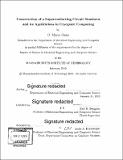Construction of a superconducting circuit simulator and its applications in cryogenic computing
Author(s)
Onen, O. Murat(Oguzhan Murat)
Download1102050937-MIT.pdf (12.27Mb)
Other Contributors
Massachusetts Institute of Technology. Department of Electrical Engineering and Computer Science.
Advisor
Karl K. Berggren.
Terms of use
Metadata
Show full item recordAbstract
In this work, I first construct a unified simulation platform, where superconducting electronics can be designed and optimized with high performance and accuracy. For this purpose, I first select numerical simulation methods that can deal with the highly non-linear characteristics of the superconducting devices. I validate the simulated responses with experimental data on device and circuit level examples. Following the implementation of the simulator, I use this framework to analyze existing superconducting nanowire based technologies, and optimize them for wider operation regimes and higher performance metrics. I use nanofabrication processes to realize these devices and conduct liquid helium immersion measurements to characterize them experimentally. Optimized devices show superior characteristics that demonstrate the predictive capabilities of this simulator. Finally, I use this simulator to design a superconducting nanowire based deep neural network training accelerator. I design, implement, and characterize a unit cell for this application. These local processors have significant device-level advantages over the readily available non-volatile memory technologies in realizing mixed-signal architectures. The devices produced throughout this work have immediate and near-term applications, proving the merit of having a high-performance simulator.
Description
Thesis: S.M., Massachusetts Institute of Technology, Department of Electrical Engineering and Computer Science, 2019 Cataloged from PDF version of thesis. Includes bibliographical references (pages 97-100).
Date issued
2019Department
Massachusetts Institute of Technology. Department of Electrical Engineering and Computer SciencePublisher
Massachusetts Institute of Technology
Keywords
Electrical Engineering and Computer Science.